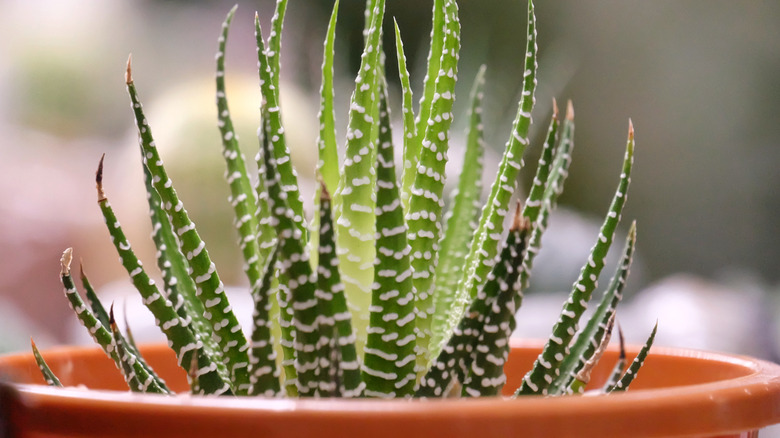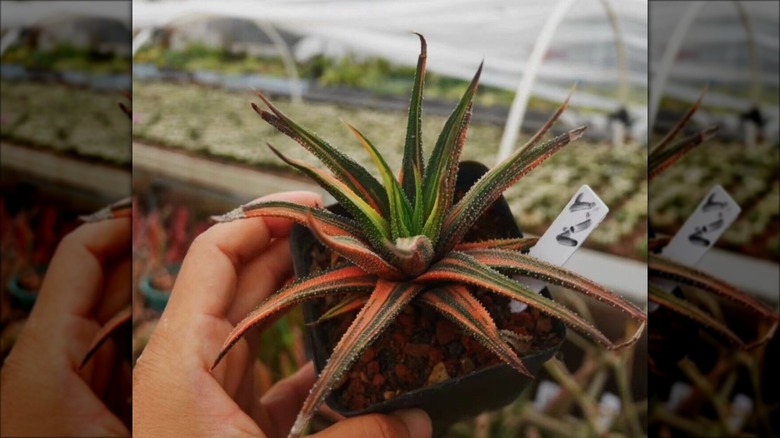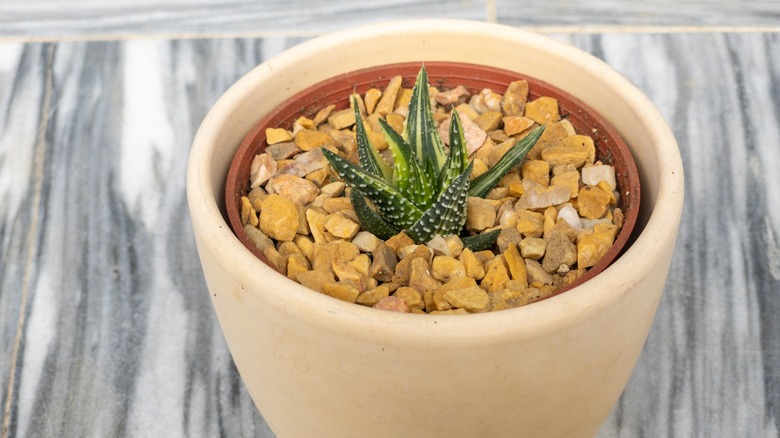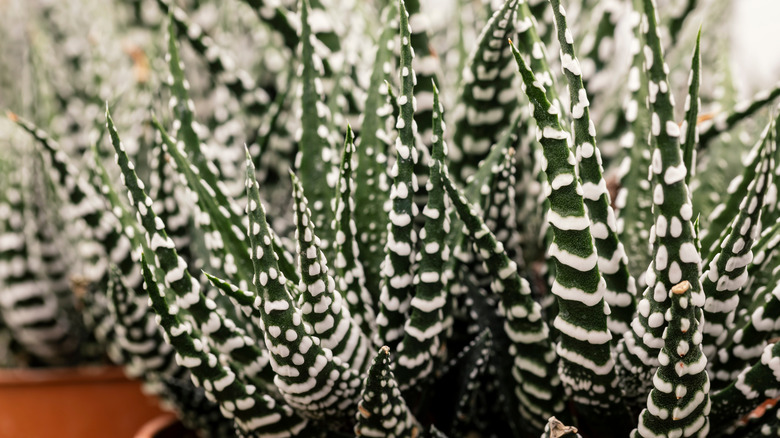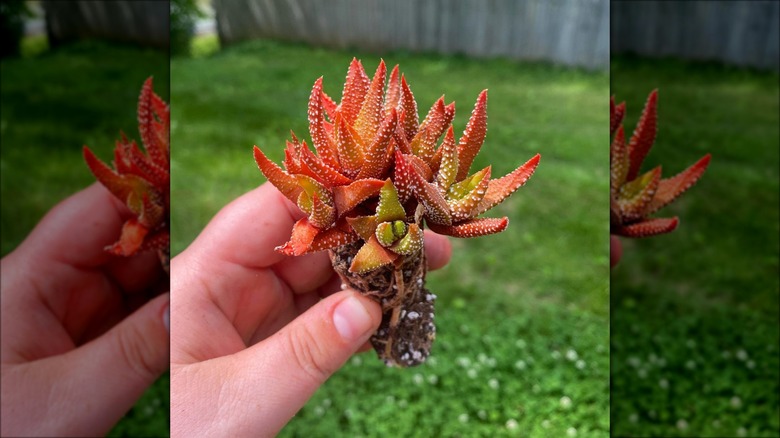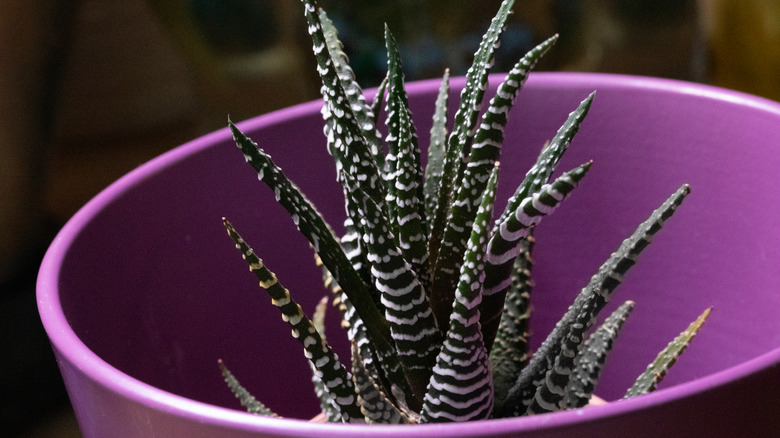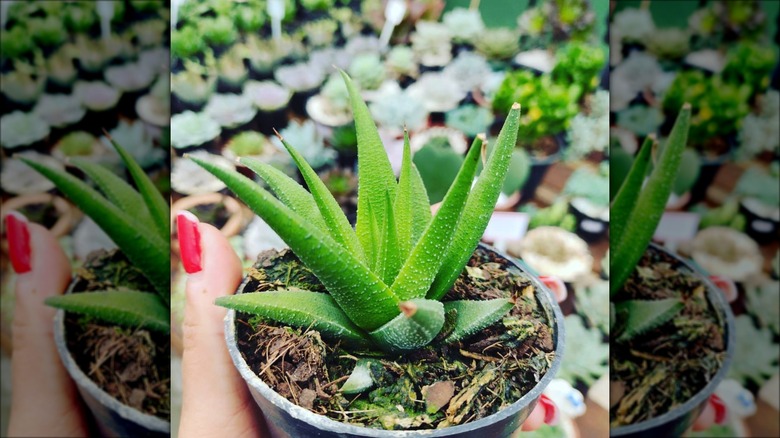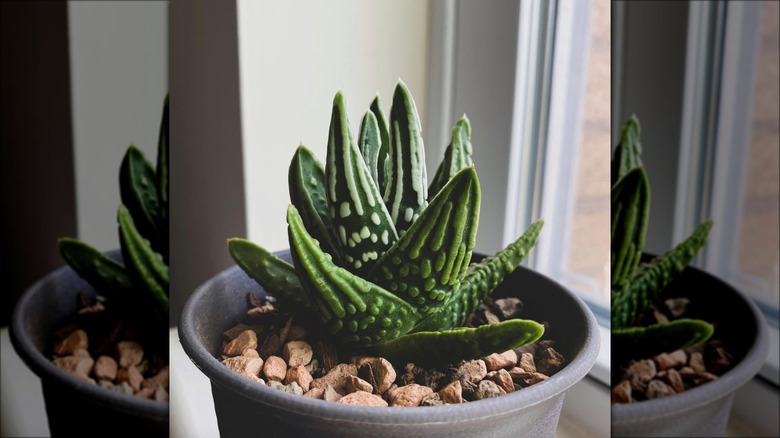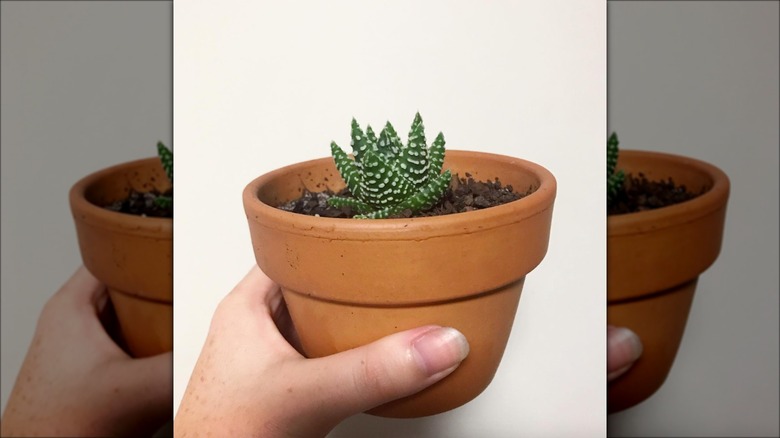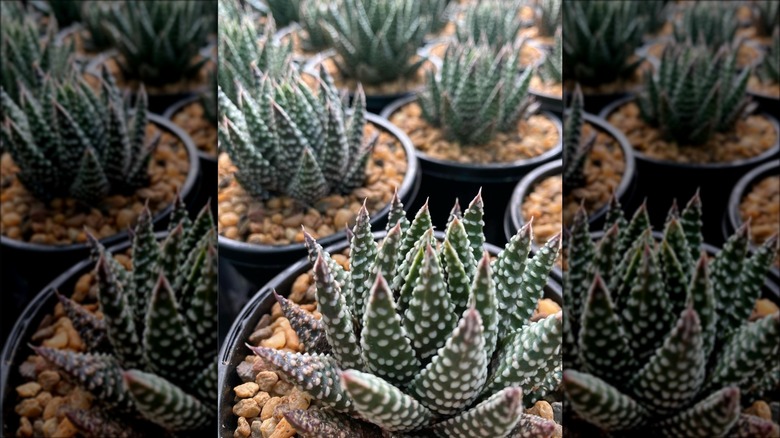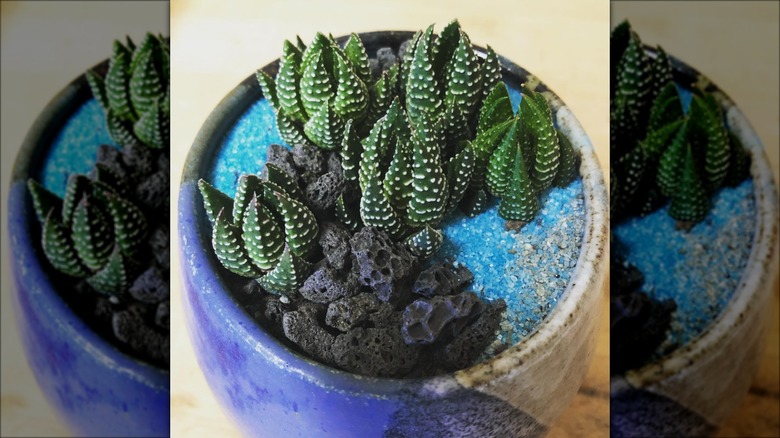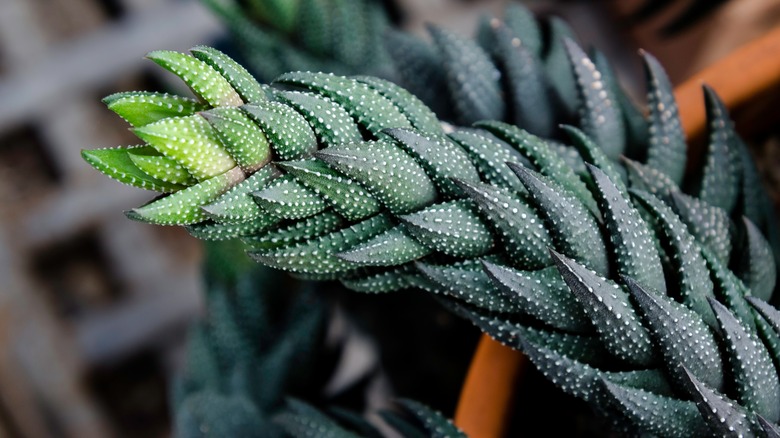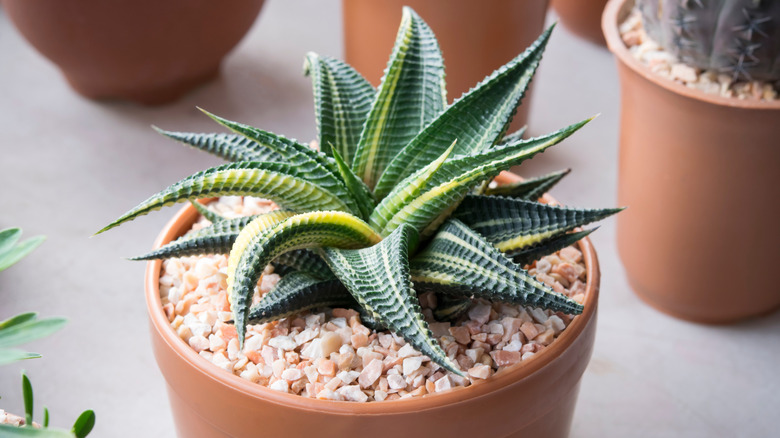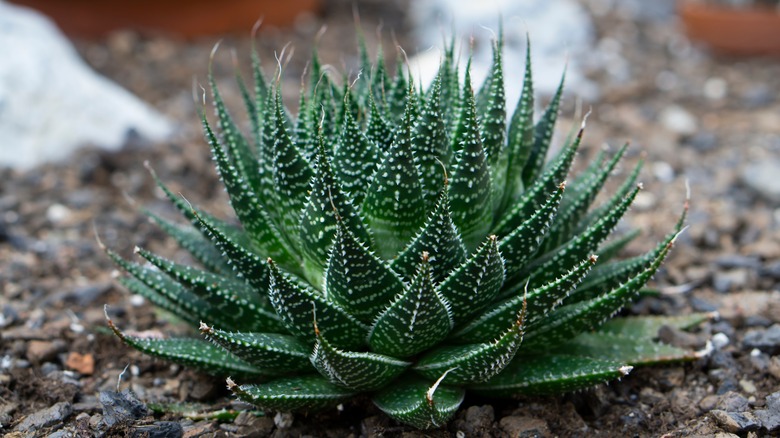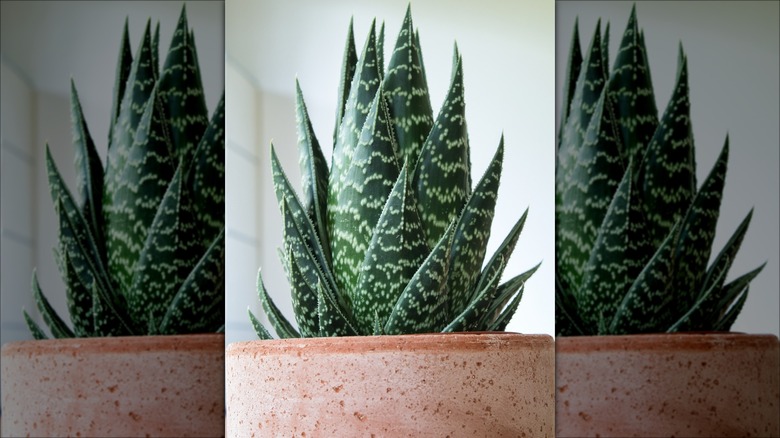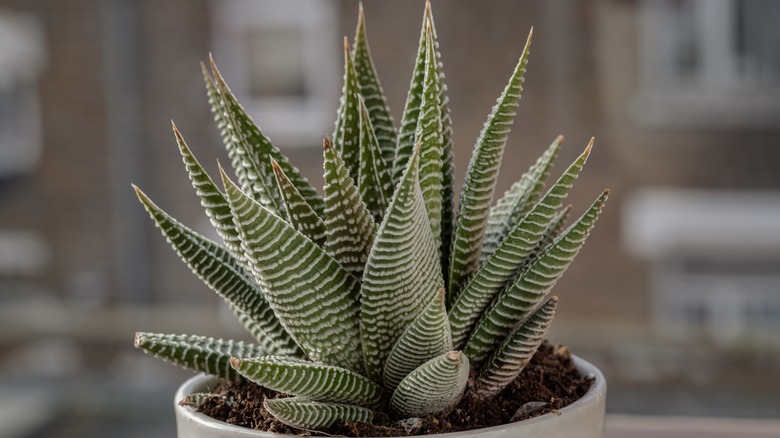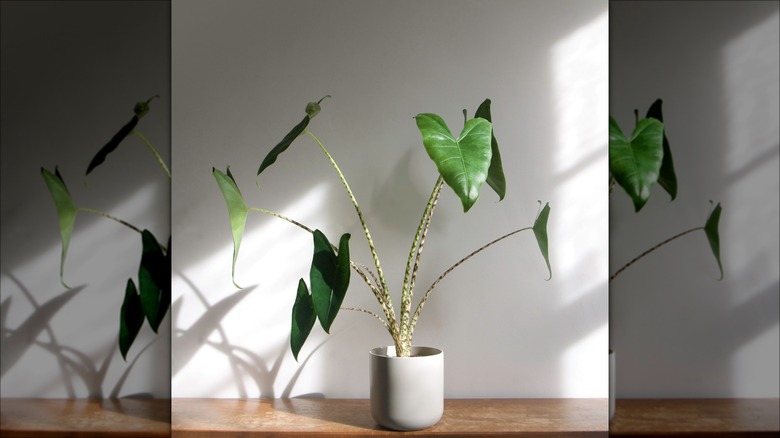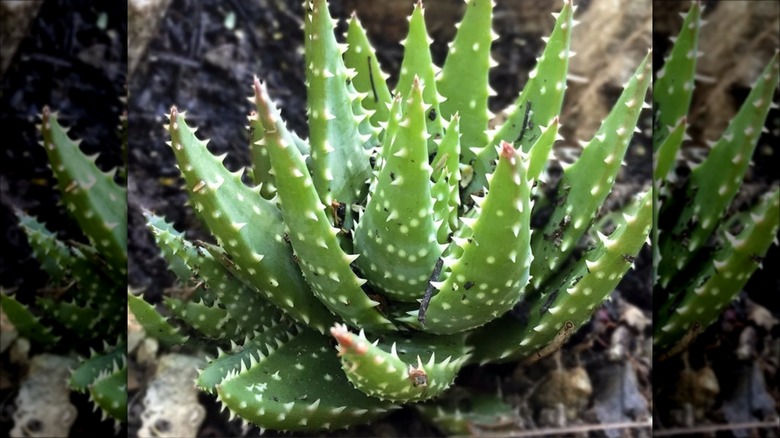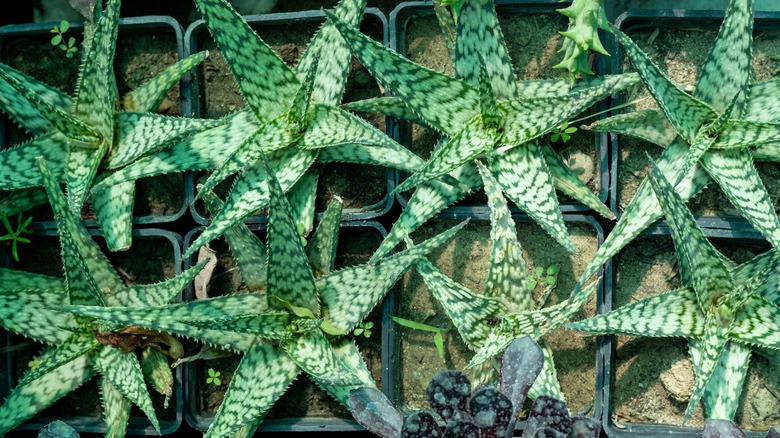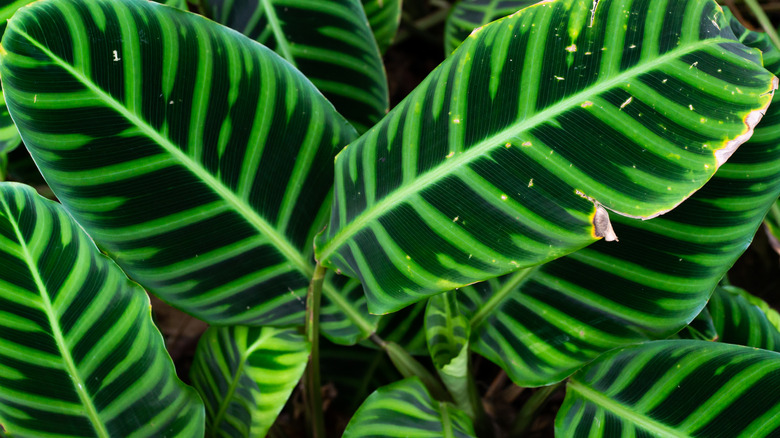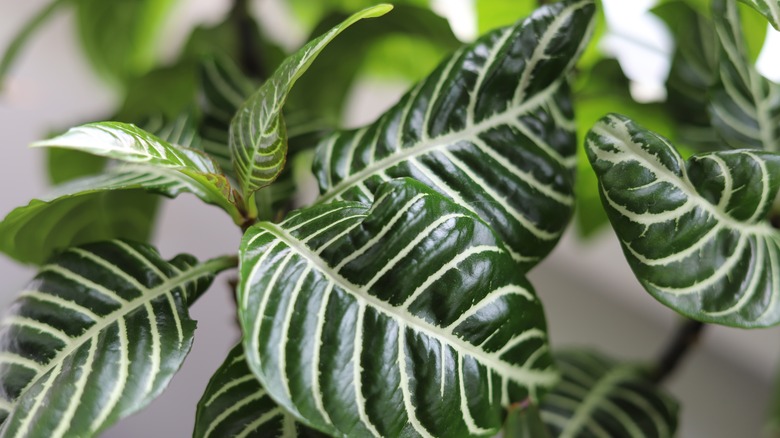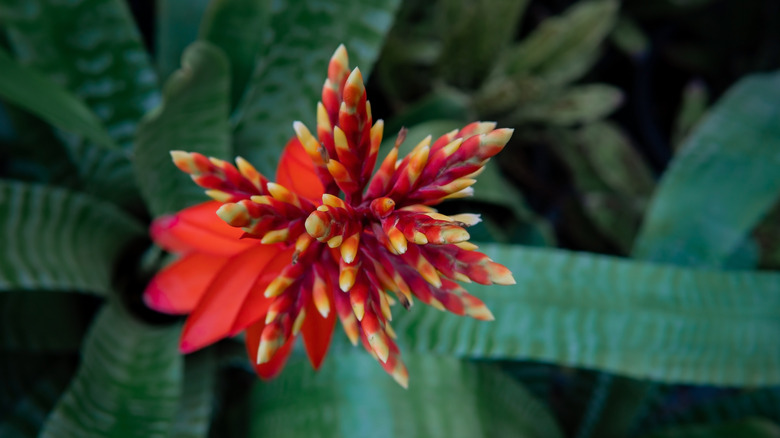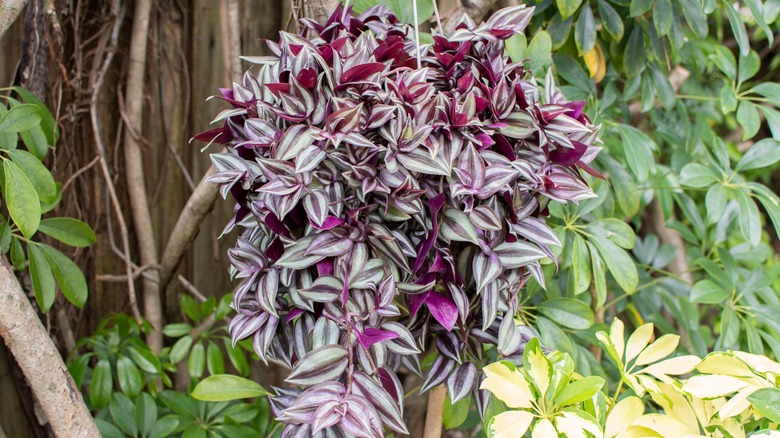22 Different Varieties Of Zebra Plant That Will Look Stunning In Your Home
We may receive a commission on purchases made from links.
In recent years, plenty of people have hopped on the trend of growing and caring for houseplants, and for good reason. Adding pops of greenery in your space can help to bring in color and brightness, developing a hobby and seeing how your efforts pay off over time can increase your feelings of self-esteem and satisfaction, and, according to a study published in the Journal of Physiological Anthropology, interacting with indoor plants can even lower both psychological and physiological stress levels. You'll be able to enjoy these benefits by caring for just a couple of potted plants, but if you've been working on your indoor collection of plants for a while and feel like you're ready to move beyond the easiest houseplants to grow, try your hand at cultivating a beautiful zebra plant.
The term "zebra plant" refers to a wide variety of plants that all share one common characteristic: a striking striped pattern. There are many Haworthia zebra plants. Haworthias are a large family of succulents that boast many different stripes, patterns, leaf shapes, and sizes. There are other succulents that share these traits as well. Then there are the tropical plants with big, bold striped leaves, such as Aphelandra squarrosa, that have little in common with the formerly mentioned succulents aside from the beautiful green and white pattern on their leaves. With such an array of options, you're bound to find the perfect zebra plant for your collection.
1. Variegated haworthia radula
The variegated haworthia radula, scientific name Haworthiopsis attenuata var. radula f. variegata, is a particularly special variant of the zebra plant that can bring unique color to your succulent garden. It features striped leaves, hence the addition of "variegated" to the title, but they don't only come in the classic green and white color scheme of other zebra plants. Instead, this succulent has stripes that come in yellow, creamy white, or even light pink. When they bloom, they display white flowers with brown veins. But the vibrant stripes add interest even when this succulent isn't blooming.
2. Hankey dwarf aloe
Haworthiopsis attenuata var. radula, commonly referred to as Hankey dwarf aloe, thanks to its origins around the town of Hankey in South Africa, is a small succulent with unique, bumpy leaves. The leaves are typically deep green in color, but the numerous bumps are bright white, creating a striking contrast between the raised pattern and the background of the leaf itself. When they bloom during their active seasons in the spring and fall, they also produce white flowers with brown veins, similar to the variegated haworthia radula.
3. Haworthia 'Big Band'
If you're looking for a succulent with a truly bold pattern that doesn't require a ton of work to maintain, 'Big Band' haworthia might be the one for you. It has striking, bright white dots along the outside of its leaves that connect to form vibrant stripes that contrast with its dark foliage, and, like many other succulents, it doesn't need much TLC to thrive throughout the year. It's a great choice if you want to amp up an existing succulent garden, but you don't want to add more steps to your plant care routine.
4. Haworthia 'Enon'
Haworthia 'Enon' is a special little plant in the Haworthia family that can make a great addition to your succulent collection. It's generally shorter than many other Haworthia varieties, making it great if you're looking for an option that will stay close to the ground. It has white dots along the surface of its leaves that easily identify it as a member of the zebra plant family. However, that's not the plant's most interesting characteristic. Its leaves can heavily vary in color depending on its environment, ranging from pale green to vibrant red.
5. Haworthia 'Super White'
If you like the look of 'Big Band' haworthia but you're looking for something a bit larger, the 'Super White' variety of zebra plant might be the choice for you. This succulent has the same bold dots that form into stripes, but it tops out at around 8 inches tall and 8 inches wide, much larger than Big Band's 3 to 5 inches. Despite the larger size, this plant is as easy to care for as just about any succulent. Keep it in a dry environment and water it occasionally during the warmer months of the year.
6. Haworthia glabrata
If the boldness of some of the other zebra plants is a bit too much for your succulent garden, consider incorporating haworthia glabrata, also known as aloe glabrata. This tiny succulent doesn't have quite as much pattern, but it can still make an adorable addition to your collection. It only grows up to about 5 inches tall at its maximum height and has thick leaves that have a bumpy textured layer along the outside. The color is typically a vibrant green, but when exposed to high levels of natural sunlight, it can deepen into a more muted brown.
7. Tulista pumila 'Emperor'
When it comes to zebra plants, the variety doesn't stop at simple differences in pattern. Tulista pumila 'Emperor' has much more rounded leaves than other succulents on this list, resulting in an almost cartoonish look. It's a compact little plant, topping out at around three inches in diameter, but its bold texture and unique shape will ensure it's a standout in your collection. Thanks to its slightly raised pattern of stripes, it's also one of the most texturally interesting options. When heavily patterned, it can look like the surface is covered in a layer of frost.
8. Tulista pumila 'Donut'
At first glance, 'Donut' might seem like a strange name for this tiny spotted succulent, but, upon closer inspection, it will begin to make sense. This little plant has green, thick leaves that look quite similar to a lot of other succulents in the same family, but the dots are actually shaped like tiny "O"s, hence the donut moniker. The plant still falls under the category of zebra plant thanks to its familial relationships with other striped plants, but if you've been on the lookout for something that's a bit closer to leopard print, keep an eye out for Tulista pumila 'Donut'.
9. Haworthia 'Royal Albert'
The 'Royal Albert' haworthia is another plant that boasts a pattern that veers closer to dots than stripes, but it's one of the most striking succulents in the family because of this. It has thick leaves, much thicker than some of the other varieties of zebra plant, and textured white bumps along its surface. While it might look like a rare find that takes a ton of work to maintain, they're one of the lowest-maintenance options out there, making them a perfect indoor plant if you're new to gardening but still want something that will make an impact.
10. Zebra wart
Haworthiopsis reinwardtii, more commonly referred to as zebra wart, is one of those plants with an ugly name but a beautiful appearance. When young, it looks similar to other kinds of zebra plants with its thick leaves, white dots that form into bands, and dark green coloring. As it grows, it begins to look more like a tower. While it is more vertically inclined than some other succulents, it still only gets to be about 8 inches tall, so it's the perfect size to keep on a windowsill in the sun.
11. Crowded Haworthia
Another example of a succulent that isn't afraid to expand upwards is Haworthiopsis coarctata, also known as crowded haworthia. It is often confused with Haworthiopsis reinwardtii, but the bumps are smaller and less flat, the leaf shape is thicker, and the leaves themselves are packed less densely together to create its trademark stacked look around the stem. The two plants do have a lot in common, as they have similar green coloring, grow to be about the same height (8 inches), and are easy to maintain as a small houseplant if you have the right amount of sunlight coming in through your windows.
12. Fairy washboard
Fairy washboard (Haworthiopsis limifolia 'Variegata') sounds like something you'd include alongside tiny doors and figurines in a fairy garden, and, luckily, the plant's appearance lives up to its unique name. This small succulent has pointed leaves that fan out from the center and boast a pattern of textured stripes. There are several different coloring options available for the fairy washboard, but one of the most interesting is the variegated variety, with irregular stripes running the length of its leaves. Combine this with the unique shape and texture of the foliage, and you have a star piece in your garden.
13. Lace aloe
In sharp contrast to Tulista pumila 'Emperor', lace aloe (Aristaloe aristata) is a plant that's pointy in pretty much every way. It has leaves that are thinner than most of the other succulents on this list, with pointed white dots along the surface, and soft white spines that extend from the sharp tips of the leaves. While it might look a bit intimidating, lace aloe is notoriously simple to care for, much like any other plant in the same family. If you place it near bright indirect light and don't overwater it, your plant should stay healthy.
14. Tiger aloe
There's a great zebra plant named after a different striped African mammal: tiger aloe. Tiger aloe (Gonialoe variegata) has the same dots-to-stripes pattern that is common among haworthias, but it comes from a slightly different family. It has fairly large leaves that can grow to 6 inches long and 2.4 inches wide, and has tiny white teeth along the edge. The plant can grow to be about a foot tall. While the stripe pattern on the leaves is largely irregular, these plants also have a white line around the border of the leaf, making them look even more striking.
15. Haworthia limifolia var. striata
If you're on the hunt for a succulent that's truly striped, look no further than Haworthia limifolia var. striata. This fashionable, tiny succulent will reach its maximum height at just under 5 inches tall and has ultra-thin stripes that run horizontally across both sides of its leaves to form a bold, but still muted pattern. Because the stripes are thin and the surface of the leaf is typically a lighter green as opposed to a deep emerald, the pattern isn't quite as bold as some of the other options, but that's what makes it a unique plant that stands out even among other zebra plants.
16. Alocasia zebrina
In a departure from the large number of succulents that are referred to as zebra plants, we have Alocasia zebrina. The leaves are large and showy, but fairly plain compared to other Alocasia plants. The interesting part is the plant's stems. Instead of being plain green like most other elephant ears, the stems boast an interesting white striped pattern, hence the zebra moniker. This plant is a bit more difficult to grow than a succulent, but if you're willing to put in the work to mimic its natural environment, it can make a great addition to your collection.
17. 'Crosby's Prolific' aloe
Aloe 'Crosby's Prolific' might not be a variety of Haworthia, but its spiked leaves can certainly give you a similar look in your garden. These aloe plants stay fairly small, maxing out at about a foot tall, and require minimal care to maintain. The spikes along the outside of its foliage lean more translucent than pure white, but they still stand out in bold contrast against the succulent's green foliage. When exposed to high amounts of sun, these leaves can fade from green to red, creating even more visual interest in an already gorgeous plant.
18. Somalian aloe
If you're looking for a showstopping focal point in your garden, the Somalian aloe is about as ornamental as you can get. The leaves have irregular stripes that run down their length, creating that sought-after zebra look. The leaves are fairly wide and come to a point at the end, giving the whole plant an attractive starburst shape. They also have spikes along the edges that add a layer of decoration. Additionally, Somalian aloe is one of the many succulents that can change color depending on their exposure to the sun, fading from vibrant green to red.
19. Calathea zebrina
Calathea zebrina is one of the larger-leafed options if you're looking for a patterned plant to add to your collection, so it makes a particularly bold impact when cultivated as a houseplant. This plant is native to Brazil, so it takes some special TLC to maintain in your home, especially if you live somewhere with low humidity levels. If you're willing to create a humid environment, give your plant bright but indirect light, and fertilize regularly during the growing season, the payoff is worth it. Calathea zebrina boasts gorgeous, deep green leaves with vibrant light green stripes throughout.
20. Aphelandra squarrosa
If you look up zebra plant, it's likely that the first plant you'll come across is Aphelandra squarrosa, and for good reason. This large-leafed plant can grow up to 6 feet tall, making it an absolute showstopper of a houseplant if you're willing to put in the work. Similar to Calathea zebrina, Aphelandra squarrosa is native to Brazil, so it takes some effort to maintain. If you're devoted to home gardening, you'll be rewarded with deep green leaves with ornamental white stripes year-round, as well as striking bright yellow flowers during the plant's more active season.
21. Amazonian zebra plant
Aechmea chantinii is a gorgeous, showy plant that has several different nicknames, but, most notably, is often referred to as the Amazonian zebra plant. This bold plant can grow 2 to 3 feet tall and 1 to 2 feet wide, so it's a popular choice as both an outdoor landscaping plant and an indoor houseplant. Its bright red, large flowers provide a bold pop of color and decoration when it blooms, but it's still a showstopper during its inactive season thanks to its large, oblong green leaves that showcase a unique white striped pattern across their width.
22. Tradescantia zebrina
Tradescantia, commonly referred to as the inch plant or wandering dude, is a popular indoor and outdoor plant that is known for its bright, purple-red coloring. Tradescantia zebrina takes this ornamentation one step further with muted green stripes along the purple leaves that contrast beautifully with this unique-colored base. This plant makes for great ground cover if you're looking to fill up a garden bed, but it can also drape beautifully over the sides of hanging pots and large planters to add dimension to your collection of houseplants.
